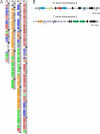Genome sequence of Babesia bovis and comparative analysis of apicomplexan hemoprotozoa
- PMID: 17953480
- PMCID: PMC2034396
- DOI: 10.1371/journal.ppat.0030148
Genome sequence of Babesia bovis and comparative analysis of apicomplexan hemoprotozoa
Abstract
Babesia bovis is an apicomplexan tick-transmitted pathogen of cattle imposing a global risk and severe constraints to livestock health and economic development. The complete genome sequence was undertaken to facilitate vaccine antigen discovery, and to allow for comparative analysis with the related apicomplexan hemoprotozoa Theileria parva and Plasmodium falciparum. At 8.2 Mbp, the B. bovis genome is similar in size to that of Theileria spp. Structural features of the B. bovis and T. parva genomes are remarkably similar, and extensive synteny is present despite several chromosomal rearrangements. In contrast, B. bovis and P. falciparum, which have similar clinical and pathological features, have major differences in genome size, chromosome number, and gene complement. Chromosomal synteny with P. falciparum is limited to microregions. The B. bovis genome sequence has allowed wide scale analyses of the polymorphic variant erythrocyte surface antigen protein (ves1 gene) family that, similar to the P. falciparum var genes, is postulated to play a role in cytoadhesion, sequestration, and immune evasion. The approximately 150 ves1 genes are found in clusters that are distributed throughout each chromosome, with an increased concentration adjacent to a physical gap on chromosome 1 that contains multiple ves1-like sequences. ves1 clusters are frequently linked to a novel family of variant genes termed smorfs that may themselves contribute to immune evasion, may play a role in variant erythrocyte surface antigen protein biology, or both. Initial expression analysis of ves1 and smorf genes indicates coincident transcription of multiple variants. B. bovis displays a limited metabolic potential, with numerous missing pathways, including two pathways previously described for the P. falciparum apicoplast. This reduced metabolic potential is reflected in the B. bovis apicoplast, which appears to have fewer nuclear genes targeted to it than other apicoplast containing organisms. Finally, comparative analyses have identified several novel vaccine candidates including a positional homolog of p67 and SPAG-1, Theileria sporozoite antigens targeted for vaccine development. The genome sequence provides a greater understanding of B. bovis metabolism and potential avenues for drug therapies and vaccine development.
Conflict of interest statement
Figures




References
-
- Bock R, Jackson L, de Vos A, Jorgensen W. Babesiosis of cattle. Parasitology. 2004;129(Suppl):S247–S269. - PubMed
-
- Gray JS. Identity of the causal agents of human babesiosis in Europe. Int J Med Microbiol. 2006;296(Suppl 40):131–136. - PubMed
-
- Smith T, Kilborne FL. Investigations into the nature, causation and prevention of Southern cattle fever. Washington (D.C.): Washington Government Printing Office; 1893. pp. 177–304.
-
- McCosker PJ. The global importance of babesiosis. In: Ristic M, Kreier JP, editors. Babesiosis. New York: Academic Press; 1981. pp. 1–24.
-
- de Waal DT, Combrink MP. Live vaccines against bovine babesiosis. Vet Parasitol. 2006;138:88–96. - PubMed
Publication types
MeSH terms
Substances
Associated data
- Actions
Grants and funding
LinkOut - more resources
Full Text Sources
Other Literature Sources
Molecular Biology Databases
Miscellaneous

